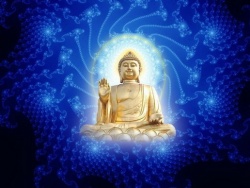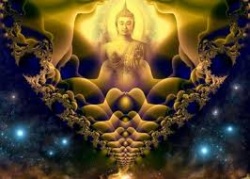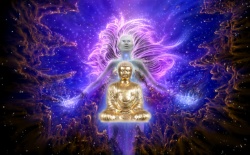Time and Space The Abhidhamma perspective
Professor Y. Karunadasa
Former Director, Postgraduate Institute of Pali and Buddhist Studies,
Lanka daily News, Aug 10, 2003
Since our idea of the void is due to the environing matter, and since all matter, from the point of view of the elemental analysis, depends on the primary elements, the space-element, too, can be said to depend on them.
In the Sarvastivada Abhidharma, too, we find its counterpart, also referred to as akasadhatu, but in this system its inclusion in matter is due to another reason: The space-element is either light (aloka) or darkness (tamas) and therefore it is included in the objective sense-field of the visible (rupayatana). In contrast, the Theravadins include it in the objective field of mental objects (dhammayatana), which means that it is not visible but can be cognized only as an object of mind-consciousness.
We find this view defended in a Kathavatthu controversy as well. In response to the view held by some Buddhist schools that space is visible because one can see the interval between two trees or two posts or the space in a keyhole or in a window, The Theravadins' reply is that in the case of an interval between two trees, for instance, what one actually sees with his eyes is only the colour of the two trees and that the interval as such is known only by the mind as an object of mind-consciousness.
Besides the space referred to above, the Sarvastivadins recognize another kind of space which is called akasa and not akasa-dhatu. It is defined not as space bound by matter but as that which provides room for the movement of matter (yatra rupasya gatih). It is omni-present (sarvagata) and eternal (nitya). Its nature is non-obstruction (anavaranasvabhava).
That is to say, it does not obstruct (avrnoti) matter, which freely exists therein; nor is it obstructed (avryate) by matter, for it cannot be dislodged by the latter. However, space is not the mere absence of obstruction (anavarana-bhava-matra), but something positively real. In view of these characteristics, in the Sarvastivada Abhidharma, space is elevated to the level of an unconditioned dharma and in this sense it is on a par with pratisamkhya- and apratisamkhya-nirodha. Thus what the Sarvastivadins call unconditioned space is the space considered as absolutely real and as serving as a receptacle for the existence and movement of material phenomena.
What could be considered as the Theravada counterpart of this kind of space is found only in one Theravada work, namely the Milindapanha. Here we find space defined as follows: In no way can it be grasped (sabbaso agayha); it inspires terror (santasaniya); it is infinite (ananta), boundless (appamana) and immeasurable (appameyya). It does not cling to anything (alagga); is not attached to anything (asatta), rests on nothing (appatittha) and is not obstructed by anything (apalibuddha). Elsewhere in the same work we are told that two things in this world are not born of karma (akammaja), or of causes (ahetuja), or of season (anutuja), namely Nibbana and space.
However, what is important to remember here is that although the Milindapanha describes space in such a way as to fall in line with its counterpart in the Sarvastivada Abhidharma, it carefully avoids the use of the term "unconditioned" (asankhata) in describing it. This is a very significant departure from its Sarvastivada version. What could have prompted the Milindapanha to take this stance is that such a description would elevate space to a level on par with Nibbana.
However, what is important to remember here is that the kind of space described in the Milindapanha is not the same as the space-element listed in the Dhammasangani. For the latter means not space in the sense of "bare geometric extension" but spaces bounded by matter. What can be considered as a parallel to the Milindapanha space is found in the Kathavatthu of the Abhidhamma Pitaka. For here too space is described more in terms of that which provides room for the existence and movement of material phenomena. However, unlike in the Milindapanha it is not described as infinite and eternal, but as something neither conditioned nor unconditioned. The commentary observes that if space is so described, this means that it is a pannatti, i.e., a nominal dhamma or a conceptual construct with no objective counterpart.
Thus in the Theravada Abhidhamma as well we find two kinds of space. What led to this idea can be traced to the early Buddhist discourses themselves. Here space is sometimes described as referring to cavities, apertures and interstices. This is what the suttas mean by akasa-dhatu (space-element), when it is counted as one of the six elements (dhatu) into which the empiric individuality is analysed. And when the Sangiti Sutta of the Digha nikaya refers to a material phenomenon that is neither visible (anidassana) nor impingent (appatigha), it is very likely that the reference is to this space element. And it is this same space-element that we find in the abhidhamma list of secondary material phenomena (upada-rupa) as the principle of material delimitation (pariccheda-rupa). Sometimes we find in the Pali suttas space described not as void region but as the ultimate basis, a sort of fulcrum or receptacle for the existence of the physical world. In the Mahaparinibbana Sutta, for instance, the Buddha is represented as saying:
"This great earth, O Ananda, rests on water, water on air, and air on space". And in the Rahulovada Sutta it is said that space for its part does not rest on anything (akaso na kattha ci patitthito). In point of fact, the Milindapanha cites this same statement in its reference to space as described there. Equal significant is an observation found in the Abhidharmakosavyakhya of Acarya Yasomitra.
It says that when the Vaibhasikas (Sarvastivadins) argue that space is real they base this argument on a sutra-passage where the Buddha declares to a Brahmin that the earth rests on the circle of water, the circle of water on air, air on space and that space for its part does not rest on anything, does not cling to anything.
It is this latter kind of space that came to be elevated in the Milindapanha almost to the level of an unconditioned dhamma. And it is also this same space that the Kathavatthu describes as neither conditioned nor unconditioned, and this, as the commentary says, means that it is a conceptual construct. In the commentaries it is sometimes introduced as infinite space (anantakasa) and boundless space (ajatakasa).
Both terms highlight its difference from the space-element in the sense of bounded space. The use of these two terms does not mean that space is regarded as something real and absolute. The use of another term, empty space (tucchakasa) does, in fact, highlight its true nature. For as noted earlier, for the Pali commentaries space in the sense of "bare geometric extension" is a mere conceptual construct. (pannatti-matta).
The reference to two kinds of space could be considered as looking at the same phenomenon from two different angles. The first, which is always introduced by the compound word, akasa-dhatu (space-element) means space as void region or as that which delimits material phenomena. The second which is introduced by the simple term, akasa (space) means space as providing room for the existence and movement of matter. It may then be asked why the former is described as conditioned (sankhata) and the latter as neither conditioned nor unconditioned (= pannatti or conceptual construct). The reason for this is that although the former is presented as one of the secondary material phenomena (upada-rupa), it is not considered as an entity distinct from the other material phenomena. It is the method followed in the Dhammasangani that in recognizing certain characteristics and modalities connected with real rupa-dhammas (elements of matter), those characteristics and modalities themselves are presented as separate and co-ordinate rupa-dhammas. It is only a pedagogic device adopted to avoid the distinction between substance and quality entering into the list of rupa-dhammas.
The Pali commentators were fully aware of this of this situation. This should explain why in the commentaries the space-element of the Dhammasangani came to be included in a category called anipphanna-rupa. What is included in this category is, strictly speaking, not a dhamma, because it has no own-nature (sabhava.) Nor is it of the nature of rupa in the sense of matter, because it does not answer to its definition. If the items included in the category of anipphanna-rupa continue to be presented as rupa-dhammas, this, as the commentators say, is done only as a matter of convention (rulhiya.)
What all this amounts to is that in the ultimate sense (nippariyayena), the space-element (akasa-dhatu) is not different from space (akasa). Both are conceptual constructs with no corresponding objective reality. This reminds us of the Sautrantika school of Buddhism where space is defined as the mere absence of the 'substance' that has the characteristic of resistance or impenetrability" (sapratighadravyabhavamatra).
Since matter is defined as that which has the characteristic of resistance or impenetrability, the above definition can be rephrased to mean that space is the mere absence of matter. This definition is intended to show that space is not something positively real but a conceptual construct having only derivative and pragmatic validity (prajnapti-sat). The addition of the word, mere (matra) is to emphasize the fact that non-existence of matter does not mean the existence of anything other than matter. Space is not the opposite of matter but the mere absence of matter. The inclusion of time and space in the category of pannattis in other words means that they are not dhammas. The dhammas, as we have already noted, are the entities that have ontological ultimacy. Hence they are often described as paramattha, that is, that which exists in a real and ultimate sense. The description of dhammas as paramattha means not only their objective existence (paramatthato vijjamanata) but also their cognizability in an ultimate sense (paramatthato upalabbhamanata).
Thus from an ontological point of view, if the dhammas represent the final limit into which the analysis of empirical existence can be pushed, from an epistemological point of view they represent the objects of higher knowledge. The pannattis, on the other hand, signify those entities that have no objective counterparts and therefore which owe their being to mind's synthetic function (kappana).
Therefore the two terms, paramattha and pannatti, could be understood as indicating two levels of reality as well: The first refers to those entities that truly exist independently of the cognitive act and the second, to those entities that owe their being to the act of cognition itself. These two categories are said to be mutually exclusive and together they provide a rational explanation for the totality of our internal and external experience. Hence it is categorically stated that apart from pannatti and paramattha a third category does not obtain (tatiya koti na vijjati). In consonance with this situation pannatti is also defined as "that which is other than the dhammas" (tato avasesa), or as "that which remains after the mental and material dhammas" (namarupa-vinimmutta).
Since time and space are two pannattis, they are definable as two asabhava-dhammas as well, that is, as two entities devoid of own-nature. Since sabhava or own-nature is not different from the dhamma, from the perspective of this definition what is qualified as asabhava amounts to an abhava, a non-existent in the ultimate sense. Hence the three salient characteristics of empirical reality, namely origination (uppada), existence (thiti), and dissolution (bhanga) are not applicable to time and space. For these three characteristics can be predicated only of those things which properly answer to the Abhidhammic definition of empirical reality. Again, unlike the real existent (= dhammas) they are not brought about by conditions (paccayatthitika). For this self same reason, both time and space can also be defined as aparinipphanna, that is, not positively produced. Aparinipphannata or positive production is true of only those things, which have their own individual essence (avenika-sabhava).
As the Abhidhamma Mulatika says, "only a dhamma that is an individual essence, with a definite beginning and a definite end in time, produced by conditions, and marked by the three salient characteristics of the conditioned existence, is positively produced". as two pannattis, another important characteristic of time and space is that they cannot be described either as sankhata (conditioned) or as asankhata (unconditioned), for to be so described they do not possess their own-nature.
Since the two terms, sankhata and asankhata, represent the totality of conditioned and unconditioned existence, the description of time and space as neither conditioned nor unconditioned is another way of referring to their non-existence as real and ultimate existents.
Again, unlike the dhammas, time and space as pannattis are not delimited by rise and fall (udayabbaya-paricchnina). Such a situation is true only of dhammas, because they come into being having been not (ahutva sambhonti) and cease to exist after having been (hutva pativenti). In contrast, time and space have no individual essence to be manifested in the three instants of arising (uppada), presence (thiti), and dissolution (bhanga). Thus, since they have no existence marked by the three instantaneous phases-the nascent, static, and cessant - temporal distinctions as past, present, and future do not apply to them. As such, both time and space are also described as kala-vimutta, that is, free from time.
Here "free from time" means that the three temporal distinctions as past, present, and future do not apply to them. That space is free from time is understandable. But how are we to understand that time is free from time, that is, free from the three temporal distinctions?
The answer to this question is that, according to the Abhidhamma, what we call the three temporal distinctions are not three phases of an absolute time but three conceptual constructs which we superimpose on the incessant flow of the dhammas. Past means the dhammas that have ceased to exist, present means the dhammas that exist, and future means the dhammas that are yet to originate.
The Abhidhamma distinguishes two kinds of pannatti. One is called nama-pannatti. It refers to names, words, signs, or symbols through which things, real or unreal, are designated: "It is the mere mode of recognizing (sannakaramatta) by way of this or that word whose significance is determined by worldly convention". It is created by worldly consent (loka-sanketa-nimmita) and established by worldly usage (lokavoharena siddha). The other, called attha-pannatti, refers to ideas, notions or concepts corresponding to the names, words, signs, or symbols.
It is produced by the interpretative function of the mind (kappana) and is based on the various forms or appearances presented by the real elements (dhammas) when they are in particular situations or positions (avattha-visesa). Both nama-pannatti and attha-pannatti thus have a psychological origin and as such both are devoid of objective reality.
Nama-pannatti is often defined as that which makes known (pannapanato pannatti) and attha-pannatti as that which is made known (pannapiyata pannatti). The former is an instance of agency-definition (kattu-sadhana) and the latter of object-definition (kammasadhana). What both attempt to show is that nama-pannatti which makes attha-pannatti known, and attha-pannatti which is made known by nama-pannatti, are mutually inter-dependent and therefore logically inseparable.
This explains the significance of another definition, which states that nama-pannnatti is the term's relationship with the ideas (saddassa atthehi sambandho). These two pairs of definition show that the two processes of conceptualization and verbalization through the symbolic medium of language are but two separate aspects of the same phenomenon. It is for the convenience of definition that what really amounts to a single phenomenon is treated from two different angles, which represent two ways of looking at the same thing.
The difference is established by defining the same word, pannatti, in two different ways. When it is defined as subject it is nama-pannatti - the concept as name. When it is defined as object it is attha-pannatti - the concept as meaning. If the former is that which expresses (vacaka), the latter is that which is expressible (vacaniya). In this same sense, if the former is abhidhana or designation, the latter is abhidheya or that which is designated. Since attha-pannatti stands for the process of conceptualization it represents more the subjective and dynamic aspect, and since nama-pannatti stands for the process of verbalization it represents more the objective and static aspect. For the assignment of a term to what is constructed in thought - in other words - its expression through the symbolic medium of language - invests it with some kind of relative permanence and objectivity. It is, so to say, crystallized into an entity.
Since time and space are two instances of pannatti, the foregoing observations on the two kinds of pannatti apply to them equally.







